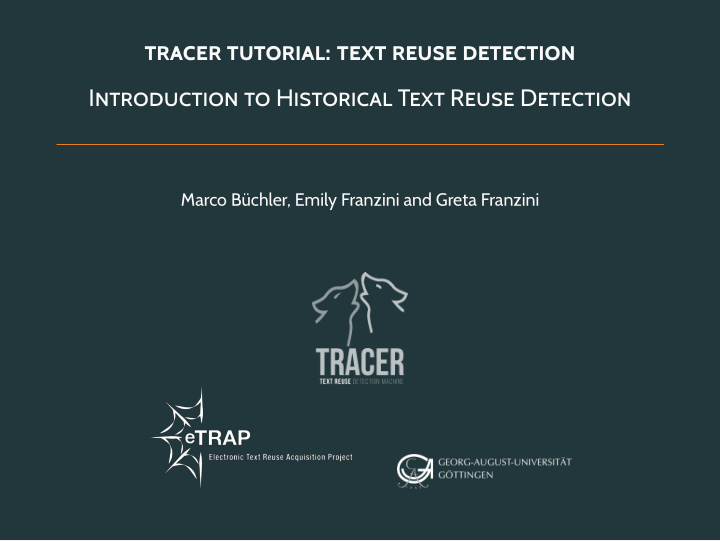



TRACER TUTORIAL: TEXT REUSE DETECTION INTRODUCTION TO HISTORICAL TEXT REUSE DETECTION M arco B¨ uchler, Emily Franzini and Greta Franzini
TABLE OF CONTENTS 1. Who am I? 2. What is text reuse? 3. Aspects of text reuse 4. ACID for the Digital Humanities 5. Big (Humanities) Data 6. Language Model 2/34
WHO AM I?
WHO AM I? • 2001-2002: Head of Quality Assurance department in a software company; • 2006: Diploma in Computer Science on big scale co-occurrence analysis; • 2007: Consultant for several SMEs in IT sector; • 2008: Technical project management of the eAQUA project; • 2011: PI and project manager of the eTRACES project; • 2013: PhD in Digital Humanities on Text Reuse; • 2014: Head of Early Career Research Group eTRAP at the University of G¨ ottingen. 4/34
MY INTERESTS :) 5/34
WHAT IS TEXT REUSE?
WHAT DO YOU ASSOCIATE WITH TEXT REUSE AND INTERTEXTUALITY? 7/34
ASPECTS OF TEXT REUSE
EXPECTATIONS OF A COMPUTER SCIENTIST: OVERSIMPLIFICATION 9/34
EXPECTATIONS OF A HUMANIST: OVERSIMPLIFICATION 10/34
TEXT REUSE FOR HUMANITIES AND COMPUTER SCIENCE Q uestion: Why is text reuse so relevant for Humanities and Computer Science? Premise: The amount of digitally available data is growing exponentially (Big Data). • Humanities: • Lines of transmission and textual criticism. • Transmissions of ideas/thoughts under different circumstances and conditions. • Computer Science: • Text decontamination for stylometry and authorship attribution, dating of texts. • gen. Text Mining, Corpus Linguistics. 11/34
TEMPERATURE MAP 12/34
ACID FOR THE DIGITAL HUMANITIES
ACID PARADIGM ACID for the Digital Humanities: • A cceptance • C omplexity • I nteroperability • D iversity 14/34
ACID FOR THE DIGITAL HUMANITIES: ACCEPTANCE I 15/34
ACID FOR THE DIGITAL HUMANITIES: ACCEPTANCE II How to be accepted by humanists if text mining is a black box we can’t look into? 16/34
ACID FOR THE DIGITAL HUMANITIES: ACCEPTANCE III Transparency: How to provide user-friendly insights into complex mining techniques and machine learning? 17/34
BIG (HUMANITIES) DATA
WHAT IS BIG DATA? Ulrike Rieß ( Big Data bestimmt die IT-Welt ): • Large amounts of data that can’t be processed and analysed manually; • Less structured data, e.g. in comparison to databases and data warehouse systems; • Linked data between heterogeneous and distributed resources. Information overload = large amounts of data (Big Data). Information poverty = noisy, missing, fragmentary, oral data (Humanities Data). COMPLEXITY 19/34
CURRENT APPROACH: TRACER 20/34
ACID FOR THE DIGITAL HUMANITIES: ACCEPTANCE IV 21/34
ACID FOR THE DIGITAL HUMANITIES: ACCEPTANCE V 22/34
ACID FOR THE DIGITAL HUMANITIES: ACCEPTANCE VI 23/34
ACID FOR THE DIGITAL HUMANITIES: ACCEPTANCE VII 24/34
ACID FOR THE DIGITAL HUMANITIES: COMPLEXITY 25/34
ACID FOR THE DIGITAL HUMANITIES: INTEROPERABILITY 26/34
ACID FOR THE DIGITAL HUMANITIES: DIVERSITY (REUSE TYPES) • Stability (yellow) • Purpose (green) • Size of text reuse (blue) • Classification (light blue) • Degree of distribution (purple) • Written and oral transmission 27/34
ACID FOR THE DIGITAL HUMANITIES: DIVERSITY (REUSE STYLES) 28/34
LANGUAGE MODEL
KEY PROBLEM Question: The distribution of Reuse Types and Reuse Styles is often unknown - which model(s) should be chosen? 30/34
OUTLINE 31/34
FINITO! 32/34
CONTACT Team Marco B¨ uchler, Greta Franzini and Emily Franzini. Visit us http://www.etrap.eu contact@etrap.eu 33/34
LICENCE The theme this presentation is based on is licensed under a Creative Commons Attribution-ShareAlike 4.0 International License. Changes to the theme are the work of eTRAP. cba 34/34
Recommend
More recommend